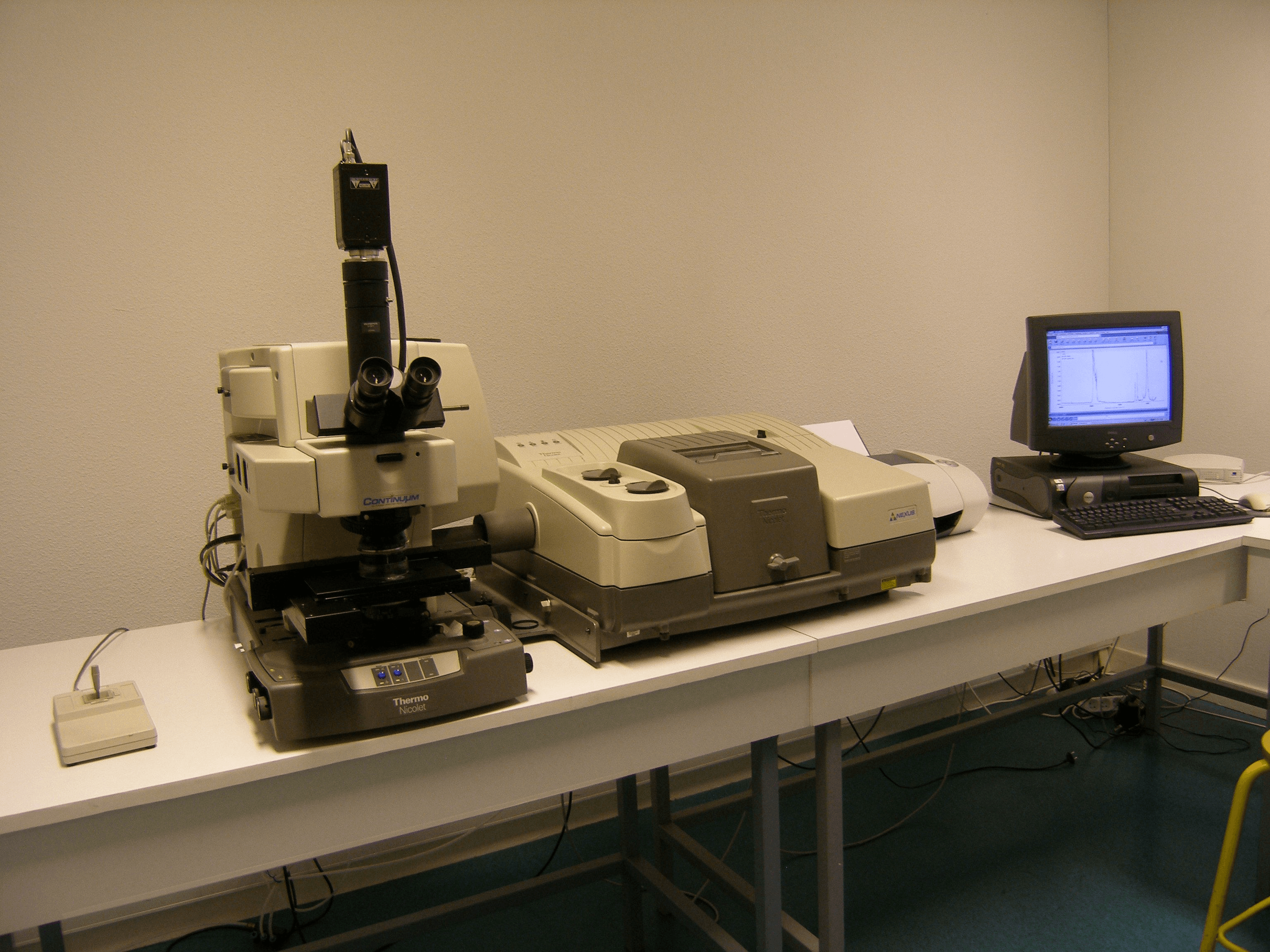Infrared Spectrometers Information
 Infrared (IR) spectrometers measure the wavelength and intensity of the absorption of infrared light by a sample. Infrared light lies between the visible and microwave portions of the electromagnetic spectrum and has a range of wavelengths. Near-infrared light is closest in wavelength to visible light. By contrast, far-infrared light is closest to the microwave region. Mid-infrared light is energetic enough to excite molecular vibrations to higher energy levels. These vibrations, which are caused by changes to a molecule’s dipole moment, occur only at those frequencies where the molecule absorbs infrared light. Because the wavelengths of infrared absorption bands are characteristic of specific types of chemical bonds, infrared spectrometers are often used to identify organic and organometallic molecules.
Infrared (IR) spectrometers measure the wavelength and intensity of the absorption of infrared light by a sample. Infrared light lies between the visible and microwave portions of the electromagnetic spectrum and has a range of wavelengths. Near-infrared light is closest in wavelength to visible light. By contrast, far-infrared light is closest to the microwave region. Mid-infrared light is energetic enough to excite molecular vibrations to higher energy levels. These vibrations, which are caused by changes to a molecule’s dipole moment, occur only at those frequencies where the molecule absorbs infrared light. Because the wavelengths of infrared absorption bands are characteristic of specific types of chemical bonds, infrared spectrometers are often used to identify organic and organometallic molecules.
Types of Infrared Spectrometers
There are two basic types of infrared spectrometers.
- Fourier transform infrared (FTIR) spectrometers are single-beam instruments that use an interferometer to spread a sample with infrared light and measure the intensity of the infrared light not absorbed by the sample. The application of a Fourier transform converts the resulting time domain digital signal into a frequency domain digital signal.
- Dispersive infrared spectrometers use visible lasers, a grating, and charged coupled devices (CCDs) to collect data. The laser acts as a light source and irradiates the sample. Most of the radiation scatters elastically at the same energy as the incoming laser radiation. A small amount, approximately one photon in a million (0.00001%), scatters from the sample at a wavelength shifted slightly from the original wavelength.
Specifications
Selecting infrared spectrometers requires an analysis of performance specifications such as wavelength range, resolution, accuracy, and infrared range.
- Wavelength range is the dispersion of the grating across the linear array, or the “size” of the spectra on the array.
- Resolution, a measure of an instrument’s ability to separate two overlapping peaks, is the width of an analytical peak at half its height. Typically, resolution is measured in nanometers (nm). At the point of resolution, two peaks of equal height are said to be resolved if the dip between the tops of the peaks is visible.
- Accuracy, another important specification, is the agreement between a mean-measured value and a true or accepted value as quantified by error.
- There are three infrared ranges for infrared spectrometers: near (0.75–3.00 µm), mid (3.00–6.00 µm), and far (6.00–15.00 µm).
Operating temperature and operating humidity are other performance specifications.
Features
There are several system configurations for infrared spectrometers. Monochromatic instruments such as Czerny-Turner designs consist of fixed entrance and exit slits, fixed focusing mirrors, and a rotatable diffraction grating. As the grating rotates, a different wavelength is focused on the exit slit. Filter systems, or polarizers, use near-infrared filters that are mounted on a temperature-controlled filter wheel and controlled by a microprocessor. Acousto-optical tunable frequency (AOTF) devices include a single-element detector and overcome many of the mechanical problems associated with multi-wavelength filter instruments. Michelson interferometers split infrared energy into beams that are then recombined optically. The two beams interfere with each other to produce a complex waveform.
There are many detector types for infrared spectrometers. Examples include deuterated triglycine sulfate (DTGS), deuterated lanthanum triglycine sulfate (DLATGS), indium antimonide (InSb), lithium tantalate (LiTaO3), and silicon (Si). Mercury cadmium tellurium (MCT) exhibits a wavelength cutoff proportional to its alloy composition. In the long wavelength spectral region, photoconductive detectors (PC-MCT) are best suited for meeting low-noise requirements. At shorter wavelengths, photovoltaic devices (PV-MCT) are suitable choices. Photoacoustic detectors measure the energy transfer from a modulated infrared beam into a mechanical vibration.
Related Information
Electronics360—TI Chipset Targets Small Portable Spectrometers
IEEE Spectrum—Quantum Cascade Laser at the Heart of Spectrometer on a Chip
IEEE Spectrum—The Truth About Terahertz
Image credit:
ishikawa / CC BY-SA 4.0
- Application Software Included
- Cooled Detector
- DTGS
- Data Processing Functions
- Data Storage / Data Logger
- Digital Front Panel
- Digital Readout
- Dispersive
- Filter System
- For use in Hazardous Environments
- Fourier Transform (FTIR)
- InSb
- MCT
- Michelson Interferometer
- Mid
- Monochromator
- Near
- Display Options: None
- On-line Monitoring & Process Control
- Output is a Switch or Relay Contact
- Outputs an Analog Current
- Outputs an Analog Voltage
- PbS
- Portable
- Self-calibration
- Serial Interface
- Step Selectable Resolution
- Telescope
- Total Vacuum Option
- Video Display
